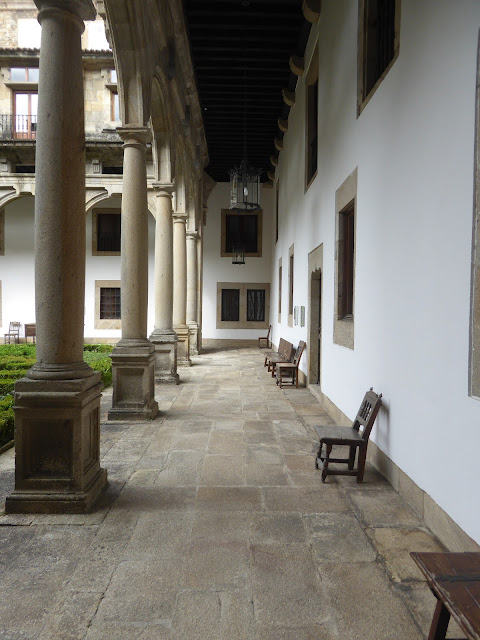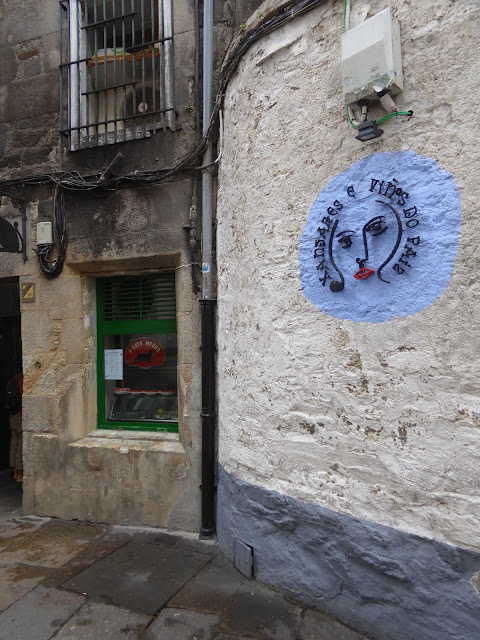A Visit to Three Cities in
GALICIA
(Part 1)
Vigo and Santiago de Compostela are cities in the far northwest of Spain in the autonomous community of Galician (shown below in red on the map). There are 17 autonomous communities in Spain, self-governed areas of the country much like states in the United States. At the same time, Comunidads are much more than simply governmental entities. Galicia has its own language and a social and cultural history sometimes quite distinct from the rest of Spain.
VIGO
"The city of Vigo has approximately 293,000 inhabitants with an extended metropolitan population of around 482,000 people. The municipality of Vigo is not only one of the major industrial cities in Galicia, but it is also one of the more important Roman centers of Pontevedra.
Vigo is the leading industrial area in Galicia with car factories, shipyards and auxiliary industry in both automotive and marine sectors. In addition, Vigo has the largest fishing port in Europe and is the home port of the world's largest fishing company, Pescanova and the most important centre of the Galician canned fish industry. The headquarters of the European Fisheries Control Agency at also located in the city."
Street Scenes
Ceramica Sargadelos
Galeria de Sargadelos Vigo
(Photo by others)
A video screen with revolving images.
How NOT to add on to a historic structure and/or
attempt to modernize it.
attempt to modernize it.
The Waterfront

Cangas
(Across the bay from Vigo)
The best I can guess is that this is recycling plant - trucks were unloading just a bit earlier. An architect(?) took a ding-bat building, dressed it up in colors and gave it some hats consisting of two askew skylights. What is not shown in the photo is that the building is sitting on a quay overlooking the magnificant bay. Even at this small and some would say, insignificant, scale, not the best example of civic design.
On the ferry.
Vigo Street Art

(Translation redacted.)
(A Few Hours In)
SANTIAGO DE COMPOSTELA
Santiago de Compostela, population 96,000, is the capital of the Galicia region. It is known as the culmination of the Camino de Santiago pilgrimage route - the Way of St. James that originated in the 9th century. Its drawing power is as the alleged burial site of the Biblical apostle St. James. His remains reputedly lie within the Catedral de Santiago de Compostela consecrated in 1211, whose elaborately carved stone facades open onto grand plaza with the medieval walls of the old town. In 1985 the city's Old Town was designated a UNESCO World Heritage Site.
"...in 813, according to medieval legend, the light of a bright star guided a shepherd who was watching his flock at night to the burial site in Santiago de Compostela. The shepherd quickly resport his discovery to the bishop of Iria, Bishop Teodomiro. The bishop declared that the remains were those of the apostle James and immediately notified King Alfonso II in Oviedo. To honour St.James, the cathedral was built on the spot where his remains were said to have been found. The legend, which included numerous miraculous events, enabled the Catholic faithful to bolster support for their stronghold in northern Spain during the Christian crusades against the Moors, but also led to the growth and development of the city."
From the UNESCO World Heritage Designation:
"The Old Town of Santiago de Compostela, together with the outlying Santa Maria de Conxo Monastery, constitutes an extraordinary ensemble of distinguished monuments. The squares and narrow streets of the Old Town contain Romanesque, Gothic, Renaissance, Baroque, and Neoclassicist buildings. This town is not only a harmonious and very well preserved historical city, but also a place deeply imbued with faith. The cathedral, considered as a masterpiece of Romanesque architecture, keeps the remarkable Pórtico de la Gloria, a jewel of the medieval sculpture. However, the authentic symbol of the city is the Baroque western façade of the cathedral, which forms one of the sides of the square of Obradoiro, one of the world´s most beautiful urban areas."
The Tourist Route to the Cathedral
From an architect's point of view, the fairly new vehicular and pedestrian entry to the Old Town could not be a better example of urban design. The city has built a multi-story partially subterranean garage where visitors are required to park their vehicles and tour buses are gathered. Above is a modern pergola structure that is the beginning of an interesting and reasonable walk into the city. Not shown, along side the route is a new library as part of the urban (re-)development.
To the right of the pergola is an framed view of the surrounding countryside. This places emphasis on the idea of the cathedral being a dramatic destination in the
rural landscape.
You enter the Old Town itself along a thoroughly reconstructed route past an outlying church (see below). Note the oddly elevated sidewalk.
Looking back at the "entry" church.
Along the route, signs of everyday life: here, a city landscaping vehicle.
And a bar with beer on tap encased in regional pottery.
As the crowds increase, finally an archway that leads into
the main city square.
If you were to continue straight ahead a companion walk takes you out of the Old Town.
Looking back at the archway entry to the square.
The Obradoiro Square. To the left, on the eastern side of the square, is the Cathedral.
Along the western side of the Praxa do Obradoiro is the 18th century Pazo de Raxoi (Raxoi's Palace), now the city hall.
The Cathedral itself is surrounded by five different squares. The Obradoiro is at the mid-right.
(Photo by others.)
On the day we visited the main facade of the Cathedral was encased in scaffolding and the doors closed to the public. Entry was routed to the northern facade.
Above, a Wikipedia photo of the interior of the Cathedral. The current construction extends to the interior, so much is covered in further scaffolding and netting. My two, blurry, interior views below are the result of the consequential bad lighting and all of the gold and silver that was creating "hot" spots.
Hostal dos Reis Católicos (Galician)
Hostal de Los Reyes Católicos (Spanish)
Parador de Santiago
1476-86 - Two original quadrangales
1800s - Additional two quadrangles
"The Hostal de los Reyes Católicos served as a hospice and a hospital, where pilgrims could recover and rejuvenate after completing the pilgrimage. The Hostal had a multilingual staff of doctors, nurses, and priests on call 24 hours a day; and provided all services free of charge. Pilgrims were allowed to recover at the Hostal for 3 days in the summer, and 5 days in the winter. As of 2014 the hotel continued to provide free services to a limited number of pilgrims....
The words hotel, hostel and hospital share the same root, based on the Latin hospes meaning guest. Nowadays, the concepts are clearly differentiated, but at the time this building started operation the idea of a hostel included sleep, food, as well as care for wounded feet and other ailments deriving from long distance walking. There was little distinction between lodging and medical care as hostels were guided by the general concept of hospitality."
(Wikipedia)
"The Plateresque front facade dates to the 16th Century....Plateresque, Spanish Plateresco, (“Silversmith-like”), main architectural style in Spain during the late 15th and the 16th centuries, also used in Spain’s American colonies. Cristóbal de Villalón first used the term in 1539 while comparing the richly ornamented facade of the Cathedral of León to a silversmith’s intricate work. Later the name came to be generally applied to late Gothic and early Renaissance Spanish architecture, since it was characterized by an intricate and minutely detailed relief ornament that is generally applied to the surface of buildings for extravagant decorative effect and without regard for structural articulation. Favourite motifs of this florid ornament include twisted columns, heraldic escutcheons, and sinuous scrolls. Clusters of this jewelry-like ornament contrast with broad expanses of flat wall surface."
Encyclopædia Britannica
******
******

The interior spaces are equally interesting.
Universidade de Santiago de Compostela
(University of Santiago de Compostela)
Other Street Scenes
Tourism and the City
Now, the not-so-good side of the city. In 2008 it was estimated that 3 million people visited the city of Santiago de Compostela. Included in this number were the 125,000 religious pilgrims as shown in the chart below issued by the Confraternity of Saint James that acts as the gatekeeper for the pilgrims. Tourism throughout Spain decreased from 2008 due to the financial crisis. Despite this downturn (only now beginning to reverse upwards), the number of pilgrims visiting the city has continually increased. The chart stops in 2014 showing 238,000 pilgrims. In 2016, the number is reported to have reached 278,000.
(As a comparison, Bilbao, the major northern city of Spain with a urban population of around 350,000 people and a metropolitan population of nearly a million people, had only 1 million tourists last year - 1/3 that of Santiago de Compostela. As an aside, much of Bilbao's tourism is credited to what is now known as the "Bilbao Effect" of architect Frank Gehry's internationally-known, Guggenheim Museum. Sometimes, new distinctive architecture helps create an environment in which tourism and concurrent city-wide redevelopment can flourish. See my posting on Bilbao: click on March, 2017 to the right-hand side of this page near the top of post. In Santiago de Compostela, the focus has been and continues to be on the Cathedral and its immediate surroundings.)
Remember, Santiago de Compostela is a city with a population of under 100,000 permanent residents. Assume you simply divided 3 million visitors per year by 365 days. That's 8,200 people per day, most all of whom want to visit the Cathedral and the other closely packed historic sites of the city. But the inflow is not spread evenly over the seasons or the days.
On busy days, the city can see an influx of perhaps as many as 25,000 tourists or more. The result has been that the Old Town has become essentially a religious Disneyland. And despite scholarly studies such as the one shown below that includes suggests proposals for reactive mitigation measures for visits to the Cathedral itself, the tourist impact has been substantial.
The Old Town has effectively taken over by tourist-oriented businesses including restaurants, souvenir shops, etc. The Cathedral itself feels like a bus station and a busy one at that. The number of day-trippers - like ourselves - wandering the streets and alleys provides a not altogether acceptable ambiance for religious observance or even secular study.
I was happy we were only there on a stopover. I was more than happy to leave. My suggestion if you are visiting? Check into the Parador and do not leave its multiple walls for the entire length of your stay.
Street Art
IIIIIIIIIIIIIIIIIIIIIIIIIIIIIIIIIIIIIIIII
The return to the parking structure.
_____________________________________
Copyright © 2017 Benjamin Clavan









































































































































